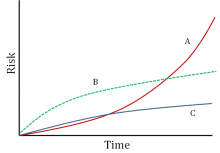Risk Tradeoffs
One unavoidable tenet of risk management is that choices made today affect all future options. For example, management choices made in the past have disrupted historical fire regimes, such that wildfires today are of much different character, magnitude, and extent than those that burned centuries ago. The net result is that vegetative fuels on much of the landscape exceed historical levels, continue to accumulate, and are likely to contribute to larger, higher-intensity fires. As a Nation, we must either accept and prepare for that eventuality or take active steps to reduce fuels. Fuel reductions carry their own risks, however, whether it comes from fire use or unintended collateral effects on other ecological or social values. Thus, all choices inherently involve trading one set of values for another.

Figure 4.1The temporal nature of tradeoffs can be visualized as a series of hypothetical curves reflecting the level of risk or expected losses over time under different national policy scenarios (figure 4.1). Line A in figure 4.1 represents the risk trajectory expected under a continuation of current policies and investments. This scenario assumes that fuel loads are accumulating in much of the landscape, expansion of the WUI continues, and climatic changes, invasive species, and other environmental factors are likely to contribute to worsening risk. Risk increases, but more importantly, the rate of increase itself increases. This leads to an ever-increasing slope much like the common compound interest curves in finance.
An alternative scenario is to return to near-historical levels of wildland fire. This scenario would aggressively address the fuels problem—leading to reduced long-term risk—but also quickly escalate overall risks beyond what is likely to be acceptable in many communities (Line B). The increase in risk seen here comes from much greater prescribed fire use and expansive use of unplanned ignitions for resource benefits.
A more ideal solution is a trajectory that marginally increases risk in the short term, but begins paying long-term benefits relatively quickly and keeps risks at manageable levels (Line C). This trajectory is consistent with the Cohesive Strategy goals of restoring and maintaining fire-resilient landscapes, creating fire-adapted communities, and safely and effectively responding to wildfire. The temporal nature of the curve helps conceptualize a national strategy that addresses risk in the immediate and short term as well as the longer-term future. The exact trajectory cannot be fully known. Each area of the country will follow a unique path, but there will be a point at which the level of fuel treatment is adequate to temper fire behavior to manageable, non-destructive levels. Simultaneously, the investments and priority actions undertaken within and near communities will increasingly reduce losses to homes and communities. The potential rise in risk in the near term is related to the risk associated with expanding the use of fire as a tool to manage fuels. This scenario also assumes that response is commensurate with local needs and works in tandem with other programs and activities.
Attaining the national risk trajectory described above and characterized by Line C will not be simple or easy. Three key assumptions or premises underlie meaningful reductions in risk:
- Prioritization of investment and use of resources. Reducing risk significantly will require that existing resources are used more efficiently. From a national perspective, this may require reallocation of resources across agencies, geographical areas, or program areas.
- Acceptance of increased short-term risk. Significantly reducing fuels across broad landscapes will require expanded use of wildland fire to achieve management objectives. Using fire as a tool carries inherent risks that must be considered in the short-term to achieve the longer-term benefits.
- Greater collective investment. Even with greater efficiency and acceptance of short-term risk, current levels of investment may be inadequate to achieve the levels of risk reduction desired. All who have a stake in the outcome, from individual property owners to the Federal government, must share the financial burden.
The wide variation in conditions and circumstances across the country makes it impractical to identify specific actions that are best suited to each and every location. Nevertheless, the analysis of landscape classes and community clusters in the National Characterization section can be combined with management opportunities explored in the Challenges and Opportunites section to suggest potential national priorities for increased emphasis.
In the following sections, the general principles for the National Strategy are outlined and the four national challenges are revisited to create spatial prioritization maps for the nation.